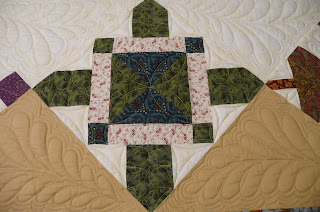Christmas Blessings to Everyone!
 |
| Border View |
 |
| A Glimpse of the whole quilt. It is large, 88 X 110 |
 |
| Pear Tree Block "and to all a goodnight" |
 |
| Center "Merry Christmas" block |
 |
| Star block |
 I am often asked how I decide what to quilt. There is not an easy answer to this, but basically, this is how I typically work. While I am working on a quilt, I hang my next one on a clothesline near my machine so that I can look at it every time I walk into the room or glace up. It keeps me thinking, and little by little a plan begins to take shape. I look for clues within the quilt to guide me - allowing the quilt to "speak" to me. This will extend from what colors to use (I find myself often trying out various colors) to what I might do in each block, section, sashing, border, etc. For a quilt like this one, I find myself thinking: " If I were a (holly, stocking, leaf, ornament, star, menorah, etc.) how would I look? Or, what background fill would look best here? I am more of a traditional quilter, although I do modern quilts as well, so most of my ideas have more of a traditional theme.
I am often asked how I decide what to quilt. There is not an easy answer to this, but basically, this is how I typically work. While I am working on a quilt, I hang my next one on a clothesline near my machine so that I can look at it every time I walk into the room or glace up. It keeps me thinking, and little by little a plan begins to take shape. I look for clues within the quilt to guide me - allowing the quilt to "speak" to me. This will extend from what colors to use (I find myself often trying out various colors) to what I might do in each block, section, sashing, border, etc. For a quilt like this one, I find myself thinking: " If I were a (holly, stocking, leaf, ornament, star, menorah, etc.) how would I look? Or, what background fill would look best here? I am more of a traditional quilter, although I do modern quilts as well, so most of my ideas have more of a traditional theme.  |
| Wreath Block |
 |
| poinsettia block |
 |
| Menorah Block |
May each of you and your families know the most blessed gift of all this Christmas.
"Thanks be to God for His indescribable gift!" (I Cor. 9:15)




.jpg)





.jpg)































